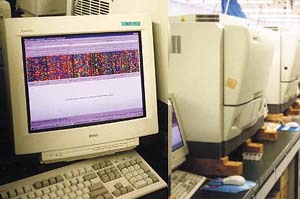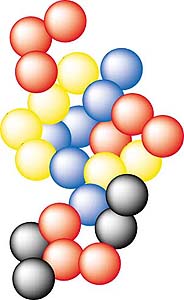Two of a Kind - Man & Ape
Back to Contents of Issue: August 2002
|
|
|
|
by Sara Harris |
|
 ONE AND TWENTY THREE HUNDREDTHS of a percent. That is all -- genetically speaking -- that separates us from our nearest animal relatives, the Pan troglodytes, or chimpanzees. This is the conclusion of a Japan-led international consortium of researchers on a mission to sequence the chimpanzee's 25 chromosomes and highlight the genetic differences between chimps and humans. They published their comparison of the two genetic maps in Science in January. ONE AND TWENTY THREE HUNDREDTHS of a percent. That is all -- genetically speaking -- that separates us from our nearest animal relatives, the Pan troglodytes, or chimpanzees. This is the conclusion of a Japan-led international consortium of researchers on a mission to sequence the chimpanzee's 25 chromosomes and highlight the genetic differences between chimps and humans. They published their comparison of the two genetic maps in Science in January."Comparisons between humans and chimps are the most efficient and effective approach to understand what makes us human," they wrote. The genetic differences, scientists argue, hold clues to chimpanzees' resistance to such diseases as hepatitis -- which Japanese researchers have used chimps to study since at least the 1970s -- and to the development of the human brain. Why do we speak and think abstract thoughts? Why are we more susceptible to certain diseases? And how much do these differences depend on our genes, how much on our learning and how much on the environment in which we live? These are the sorts of questions researchers are asking as they map the chimp genome. And as the project progresses, they may find themselves answering more questions about the animal rights impact of their research and whether all the hard work will lead to commercial success. Missing link The factors involved in mapping and analyzing the chimp genome are multiple and complexly intertwined -- the hormones as well as the physical attributes, like hair, that distinguish humans from chimpanzees are the manifestations of proteins, not genes. But the genome is where the directions to make those proteins lie. The work of decoding the genome and laying the groundwork for genetic comparison, argues University of Tokyo professor Yoshiyuki Sakaki, the leader of the international consortium decoding the genome, will lay the foundation for further study in, for example, neuroscience and evolutionary biology. The International Chimpanzee Genome Sequencing Project grew up in the shadow of the much-heralded Human Genome Project (HGP). Sakaki himself was an HGP project leader at the Riken Genomic Sciences Center (run under the auspices of the Ministry of Education, Culture, Sports, Science and Technology). Sequencing the chimpanzee genome is providing a chance for a second tier of biotech-capable nations, many of which cut their teeth on HGP, to build up their sequencing strength and raise their profile in the international scientific community. Japan, which contributed 6 percent of the human genome sequencing data, has teamed up with China, Germany, South Korea and Taiwan. However, the consortium's research is being conducted as the number of chimpanzees worldwide is dwindling. The ethics of conducting research on endangered animals, concerns regarding animal treatment -- especially when it comes to the highly developed chimpanzees -- and religious concerns regarding what it means to be human are all issues looming in the background. The consortium's results have energized the scientific community. But groundbreaking work in the field -- the publication of an estimate of 98-99 percent similarity to humans -- was published in 1975. If the intervening decades have brought us less than half a percent of precision, why the renewed excitement? While the consortium's work published in January is essentially a confirmation of the 1975 paper, the new methods used and the range of the work -- calculation this time covered the whole genome, not just certain genes or regions -- make the results significant. Furthermore, the consortium's map comparison revealed that genetic differences are clustered, not distributed randomly. One percent may seem small, yet if you lined up the 3 billion units said to make up the human and chimpanzee genomes, there would still be 30 million individual differences. "The genome contains some uneven distribution," explains Sakaki. "We found some particular regions very much variable and parts more stable." This has led the consortium's researchers to focus their efforts on what they consider a particularly fruitful region: human chromosome pair 21, which is analogous to chimp chromosome 22. (Evolution has given chimpanzees 25 pairs of chromosomes and humans 24 -- in the 5 million years between the two species, chromosome pairs 12 and 13 fused.) Sasaki indicated that consortium researchers had identified 20 such 'hot spots' so far. Taiwan team head and National Yang-Ming University professor Peter Tsai says, "There may be hundreds." 
 Needle in a haystack
Needle in a haystackThe results have drawn the attention of Lee Silver, Princeton University professor of molecular biology and public affairs and author of a controversial book on the ethical and political implications of genetics called Remaking Eden: Cloning and Beyond in a Brave New World. He found the research so promising that he paid Sakaki a visit. "It seemed that there was a strong possibility that it would be impossible to find the 'needle in the haystack' differences that were really significant ... from the vast majority of DNA differences that have no impact on the essential features that distinguish us from chimps," he wrote recently. "The new data coming out of Japan shows that we have more reason to be optimistic that we will be able to identify the particular genes and other DNA regions that have evolved most rapidly and are more likely to be significant." The obvious question is, how much more precise can the comparison get? In fact, there is a lot of ground yet to cover. For its January paper, the consortium sequenced short sections of the chimpanzee genome, then lined them up on a map of the human genome. The matching sections were then compared to come up with the 1.23 percent figure. However, while these sections were from all over the genome, the total amount sequenced was only 5 percent. A mere 2 or 3 percent matched up with the human genome directly. Although the two genomes share long stretches of similar genetic sequence, evolution has rearranged the order. The genetic code has been subject to inversions, insertions, deletions and duplication. "We need more sequence data," says Sakaki. "We need to know 30 percent or 50 percent. That is not enough, but very powerful for understanding." With a goal of sequencing 30 percent of the genome within three years, the project is scheduled to receive JPY7 billion from the Japanese government. Understanding the brain "I think the important thing is the genes and their regulatory regions. That probably makes up 30 percent of the genome in total," Sakaki explains. "So we should focus on 30 percent to obtain very precise data, then we can say what kind of genetic change causes or promotes the progress of the human brain or causes us to be human." The international research project started coming together in March 2001 with a meeting in Japan of about 170 researchers from around the world known as the GEMINI Workshop on Ape Genomics. Those in attendance included scientists from Riken's GSC and Brain Science Institute and Japan's National Institute of Genetics. Sakaki also invited participants from Germany's Max Planck Institute for Molecular Genetics and Leipzig Primate Center, the Yang-Ming University Genome Research Center in Taiwan, South Korea's Research Institute of Bioscience and Biotechnology and the National Genome Center in Shanghai. At that meeting, the future consortium participants sent out their first call for collaborators, and they also began comparing notes on the availability of funding and sequencing capacity. The majority of the sequencing performed domestically is done at Riken's Genomic Sciences Center facility in Tsurumi, Yokohama; the total domestic effort involves some 50 researchers in Japan, at Riken, the National Institute of Genetics and the University of Tokyo. However, GEMINI, or the Genes and Minds Initiative, is more than just a sequencing effort. It also brings together the evolutionary biologists and brain scientists who can best put the emerging sequencing data to use. Taking charge Japan jumped into an opening. Once work on the human genome dwindled, scientists at sequencing centers around the world needed to decide what to devote their sequencing machines to next. "From a scientific viewpoint, the chimp genome is very important, an essential genome to be analyzed," says Sakaki. "But the problem is priority." Perhaps with an eye to speedy results, the two leading countries in the HGP turned to comparative genomics projects focusing on the mouse and the zebra fish. It was an approach Sakaki deems reasonable. "But also we are thinking what we should do as Japan," he added. "We [considered that] after the rat or mouse, or fish, we absolutely needed to know a big primate genome," he says. It was not a foregone conclusion. In fact, the value of comparative genomics with chimpanzees is a matter of some controversy. Scientists are divided not over the value of the data, but the cost of getting it. Sequencing the mouse genome -- estimated to be 60 percent similar to humans -- will help clarify the biological functions and responses common to mammals. Former Celera Genomics president and CEO Craig Venter was famous for his resistance to chimpanzee genomics, arguing that ferreting out the truly significant research targets would take too much time and be too costly. It wasn't a project Celera would take on. "Of course it is not easy to find out what is essential," Sakaki says, "but it is also very certain that that kind of essential information is there in the difference between human and chimp. So I think that is a very important starting point to understand ourselves." It may simply come down to who is willing to put forth the money. It "doesn't make sense for commercial results," Tsai says. "I don't see a point, from a commercial point of view, to sequence the chimpanzee genome. It's still a long shot from sequencing to some product."  Religious worries
Religious worriesPerhaps capacity wasn't the only reason US researchers shied away from tackling a primate. Indeed, several scientists had gotten together in 1998 to find ways of promoting a US chimpanzee sequencing project. "I think part of the reason that the US has dropped the ball on this project," writes Silver, "derives entirely from the possibility that the work could lead us to an understanding of the genetic instructions for creating a so-called 'human soul.' This is a frightening thought to those who are very religious because it would take the soul away from God and put it strictly in the domain of cells and molecules. "Just as the Pope tried to stop Galileo from using his telescope to discover that we are not at the center of the universe, American leaders would be quietly delighted to stop research that could challenge the core beliefs of the Christian religion," he continues. Not so Japanese leaders. In fact, Sakaki says, in general people in Japan have welcomed the project. Public opinion is supportive, he says, because humans are naturally curious about what makes the difference between humans and chimps. "Japan is in a good position to do this kind of project," he says. But religion is not the only ethical concern facing the project. The International Red Book identifies chimpanzees as an endangered species; estimates of numbers worldwide range from 50,000 to 250,000 -- down from millions 100 years ago. The blood samples used for the consortium's research are from a colony of about 100 chimpanzees in Primate Park, a facility in Kumamoto run by Sanwa Kagaku Kenkyusho. According to the animal protection group ALIVE (All Life in a Viable Environment), as of December 1999 there were a total of 391 chimpanzees in 58 facilities throughout Japan; an estimated 65 percent of those in zoos. The Kumamoto facility is the only chimpanzee colony in Japan and reportedly one of only nine in the world. The chimpanzees there are mostly the remaining members and descendents of 140 to 150 chimpanzees imported to Japan from Africa for hepatitis B experiments in the 1970s. One expensive monkey park The financial burden on Sanwa, which spent a reported JPY250 million in 2000 to run the facility, is significant, if not crippling. In light of the cost to the nation's researchers of using blood and tissue samples or 'borrowing' individual chimps, the Japan Primate Society has requested that the country's chimpanzee facilities be nationalized. But what conditions the animals are kept in, how they are treated and the stress they incur when giving blood samples are all points of concern for ALIVE. In vaccine research, for example, lowered immune resistance due to stress can significantly affect results, the group says. Director Fusako Nogami says that when the freedom of information act expands to include such nationally supported facilities as Riken, ALIVE will request information on plans for research using chimpanzees. A statement on the group's Web site delineates their position: "Primates are the closest relatives of the human species, and feel psychological stress and physical pain much like us. Hence experiments on primates are equal to experiments on humans. Performing such experiments in the backroom, unchecked and allowing no discussion of the wider theoretical implications, is in contravention of societal norms." The group has petitioned the government in opposition to the nationalizations scheme, and campaigned for better conditions for the animals and end to research on chimpanzees. Even in the face of these concerns, however, interest in the consortium's sequencing work is growing. Since the publication of the Science paper, Sakaki has received more collaboration requests than the consortium can accommodate. One was from the US NHGRI, which announced May 22 that the chimpanzee would figure prominently on a new list of national sequencing priorities for when capacity is expected to free up later this year. Even Celera Genomics wants in. With an eye to potential drug targets, they have requested information about individual genomic differences known as SNPs (pronounced "Snips," and short for single nucleotide polymorphisms) that could help identify susceptibility to disease. Veil of secrecy And they are not the only commercial interest to pursue this angle on comparative genomics. The other big chimpanzee genome analysis effort in Japan is being carried out by Takara Bio subsidiary Dragon Genomics. In November 2000, they announced a collaboration agreement with Sanwa Kagaku Kenkyusho. Sanwa provides the blood samples and Dragon performs high-throughput sequencing and functional analysis, according to the press release, but the research is being conducted under a veil of secrecy. Takara Bio spokesman Yoshihiro Hayashi would only reveal that the research announced in 2000 "has progressed." He did say, however, that the company is using bead technology licensed from the US company Lynx to analyze the gap between the two genomes, looking to come up with drug target information that it can patent and then license. As the public project grows, Japan may face an increasingly precarious balancing act. The individual members are eager to prove what they can do and get a leg up on their rival participants. Already the participating countries are elbowing competitively for a bigger role. "In the long run, I think we would like to choose a chromosome and coordinate it for the international effort," says Tsai. Sakaki says, "In the case of the human genome, it's mostly a US-dominated project. Of course we are collaborating. But this time we hope it will be a more equal partnership. The chimp genome sequence is, itself, not the final goal -- that is the starting point to understand ourselves." As the research leads to a bigger role for physiologists, neurologists and other scientists, the larger GEMINI community will come into play. "The role of genomic science is [within] the first three years," Sakaki stresses. Plans for the future What does the future hold? For one, Sakaki would like to expand the scope of the current project beyond the three chimpanzees -- two males and a female -- researchers have gotten samples from so far. While admitting the difficulty of getting blood samples from chimpanzees in the wild, Sakaki showed interest in expanding the data to include more individuals and chimpanzees in zoos. Some researchers would like to advance sequencing research on other monkeys, like the macaque, to provide yet more detailed comparisons. The two major fields to which these data are expected to contribute are evolutionary biology and neuroscience, especially the development of drugs and other therapies to treat developmental and neurological disorders. "The brain is maybe the most important frontier of life science for the coming 20 years," Sakaki says. If, as Sakaki argues, the consortium's genetic data provides the basis for unifying scientists' observations of animal behavior, the potential for its impact could be significant. "I think if we learn what kind of environmental factor stimulates what kind of brain function, then we can learn how we should spend our days," he predicts. "I hope we can learn more about how people feel happier (as a result of) environmental factors." @ |
|
Note: The function "email this page" is currently not supported for this page.





